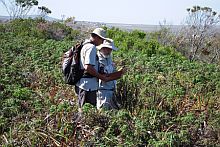Needle in a haystack?
|
|
Help wanted in designing permanent plot markers While some of the plot markers in the Table Mountain National Park are concrete pillars, others are metal fence droppers, piles of rocks and even a wooden stake that seems to have avoided fire. With SANParks, SAEON is looking for permanent markers that will not corrode, can survive fire, are not unsightly and won’t harm wildlife. If anyone has suggestions we would love to hear from you. |
SAEON, in collaboration with South African National Parks (SANParks), is hoping to secure plots in the Table Mountain National Park as a valuable long-term monitoring resource for fynbos vegetation.
The problem is that nature seems to have reclaimed its territory over time, obliterating some of the vegetation plot markers.
During 1965-66, vegetation scientist and ecologist Hugh Taylor, working for the erstwhile Botanical Research Institute, established 100 marked vegetation sites in what was then the Cape of Good Hope Nature Reserve. These plots can be linked to management records, including fire history dating back to the 1940s.
After him fynbos ecologists Sean Privett and Prof Richard Cowling saw the advantage of using these plots to further understanding of the resilience of fynbos over time. Sean resurveyed the plots in 1996 and relocated 81 of the original 100 sites.
In 2008, Jasper Slingsby of the University of Cape Town’s (UCT) Botany Department alerted SAEON to the existence of these plots, and to his perception that many of the plot markers were deteriorating as a consequence of fire and the corrosive sea air.
SAEON decided to track down all existing plot markers and get GPS locations of their position. Jonathon Aronson and Glenn Moncrieff, both students at UCT, thrashed through several hectares of vegetation and managed to relocate just over half the plots.
Some of the plots are lost forever under carparks and braaispots. On the west coast, two plots have been buried by advancing dunes - one in the thirty-year period between Hugh Taylor’s and Sean Privett’s surveys, and one more recently.
Ikapa Honorary Rangers to the rescue!
The iKapa Honorary Rangers - a group of volunteers active in the Table Mountain National Park to help alleviate the workload of full-time rangers - have now come to the rescue by volunteering to look for the markers in the Cape of Good Hope part of the Table Mountain National Park. Two of these rangers, Eileen Hoal and Paul van Helden, have made a start by locating some of the missing poles.
Hunting for sites resembles something of a treasure hunt. The locations of the plots are only known from dots on a map. To find a plot, the searchers start with roughly estimated coordinates and a GPS, and when lucky, Hugh Taylor’s photos may show unique rock or other features that can be matched to a rough location. Then it is a case of wandering around until a marker is found. But even in burnt sites a knocked over pole or fence dropper can be amazingly elusive.
What has research on the Cape of Good Hope vegetation plots revealed so far?
On average there was a 40 % turnover in species at the sites over the whole reserve between 1966 and 1996. At the extremes, one site retained only 43% of its original species and another site retained 84% of species. However, at the metacommunity level, species composition remained stable.
Local diversity remained similar at both dates despite turnover of species. Rare species were no more likely to disappear than common species. Interestingly, resprouters were as likely as other species to disappear from a plot.
These patterns can be ascribed to the effect of fires in opening up opportunities for plants to disperse and reestablish in the intervening years. This in turn suggests that disturbance allows for high species diversity by preventing competitive exclusion by dominants.
What are the implications for global change monitoring?
Since species presence and abundance at the local (plot) level is so variable, but stable at the metacommunity level over decades, sampling strategies for detecting global change impacts need to include a large number of plots to ensure that stochastic1 environmental factors do not mask change.
1 Instead of dealing with only one possible 'reality' of how the process might evolve over time (as is the case, for example, for solutions of an ordinary differential equation), in a stochastic or random process there is some indeterminacy in its future evolution described by probability distributions. This means that even if the initial condition (or starting point) is known, there are many possibilities the process might go to, but some paths are more probable and others less (Wikipedia).
Further reading:
- Privett, SDJ, Cowling RM, Taylor, HC (2001) Thirty years of change in the fynbos vegetation of the Cape of Good Hope Nature Reserve, South Africa. Bothalia 31: 99-115
- Thuiller W, Slingsby JA, Privett SDJ, Cowling RM (2007) Stochastic Species Turnover and Stable Coexistence in a Species-Rich, Fire-Prone Plant Community. PLoS ONE 2(9): e938. doi:10.1371/journal.pone.0000938













